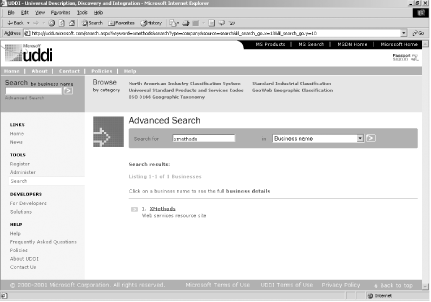Service Discovery: UDDI
UDDI currently represents the discovery layer within the web service protocol stack. UDDI was originally created by Microsoft, IBM, and Ariba, and represents a technical specification for publishing and finding businesses and web services.
At its core, UDDI consists of two parts. First, UDDI is a technical specification for building a distributed directory of businesses and web services. Data is stored within a specific XML format. The UDDI specification includes API details for searching existing data and publishing new data. Second, the UDDI Business Registry is a fully operational implementation of the UDDI specification. Launched in May 2001 by Microsoft and IBM, the UDDI registry now enables anyone to search existing UDDI data. It also enables any company to register itself and its services.
The data captured within UDDI is divided into three main categories:
- White pages
This category includes general information about a specific company; for example, business name, business description, and address.
- Yellow pages
This category includes general classification data for either the company or the service offered. For example, this data may include industry, product, or geographic codes based on standard taxonomies.
- Green pages
This category includes technical information about a web service (a pointer to an external specification and an address for invoking the web service).
Figure 1-13 shows a sample screenshot of the Microsoft UDDI site. From this site, you can easily publish your own services or search for existing ones.
Full details on UDDI are available in Chapter 7.
Get Web Services Essentials now with the O’Reilly learning platform.
O’Reilly members experience books, live events, courses curated by job role, and more from O’Reilly and nearly 200 top publishers.


